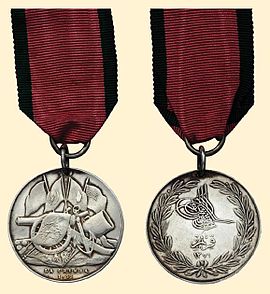Design and identification
The medal is silver and 1.4 inches (36 mm) in diameter. [3]
The obverse shows the Ottoman Sultan’s tughra with the Muslim calendar year of 1271 on all versions. [3]
The reverse depicts a cannon standing upon the Imperial Russian flag, with an anchor and a mortar. The four flags of the allies are to the rear, their order identifying the country for which the medal was intended, either Great Britain, France or Sardinia. The identifying flag is the central right hand flag, positioned above the anchor, the Union Flag for Great Britain, the tricolour for France or the flag of the Kingdom of Sardinia, based on the Italian tricolore. Since Sardinia was ruled at the time by the House of Savoy, this flag has the Savoy shield in the central panel. [4] The Turkish flag is placed centre left on all three versions. [3] The inscription in the exergue reads "Crimea 1855" for British issue, "La Crimee 1855" for French issue, and "La Crimea 1855" for Sardinian issue. [3]
Due to the loss by shipwreck of 22,000 of the medals intended for British recipients, [5] many awards were made with whatever issue came to hand, the most common being of the Sardinian type. [4]
Over the years many have mistakenly believed the flags and cannon to be the obverse of this medal, and many of the recipients wore it that way. The side with the Sultan's cypher or tughra is the correct obverse, although most collectors today continue to mount the medal with the flags and cannon as the obverse.
The general quality of these medals was poor and some British officers had copies of superior quality made in 925 silver with plain or scroll suspenders. These have clearer detail and are generally thicker and heavier; they are often seen in groups mounted by Messrs. Hunt and Roskill. The British versions of this medal are also generally believed to have a slightly higher silver content than the French or Sardinian versions. [3]
Ribbon
The ribbon is watered and of dark crimson with green edges. The original ribbon issued with this medal measured only .5 inches (13 mm) wide (similar to a miniature medal ribbon) and often used two widths, but it was usually replaced by one of 1.25 inches (32 mm) when awarded to British personnel. The medal was originally suspended via two small steel rings, although the one on the medal itself can be silver. Not only did they tend to rust, but these rings were almost universally altered to take the wider ribbon conforming to standard British type. Other suspensions were also used and therefore many medals are found with a privately attached scroll or other suspender akin to British medal types.
Naming
This medal was issued unnamed but examples are found with privately engraved naming of varying styles.
Criteria and numbers awarded
While the Sultan offered the medal to Turkey's three allies, it was left to each country to decide how many to accept and the criteria of award.
The United Kingdom awarded 74,000 medals for all ranks of the Army who qualified for the British Crimea Medal and who had survived the war; [1] with a further 25,000 for the Royal Navy. [5] Queen Victoria gave permission for the medal to be worn in uniform. [6]
France ordered only 1,500 medals for award to French troops who had served in Turkey. The French commander in the Crimea, Marshal Pélissier, described the medals as poorly made and of “little attraction”. There was no Imperial Decree permitting its wear in uniform, in contrast to the British Crimea and Baltic Medals, both of which were authorised by Imperial Decree for wear by French recipients. [1]
Sardinia accepted 5,000 Turkish medals, which were awarded to selected officers and men of their forces who distinguished themselves in the campaign. [1]
As many British recipients were finally issued with the medal designed for Sardinian – and sometimes French – troops, [3] the number received by each country does not indicate the number awarded of each design.
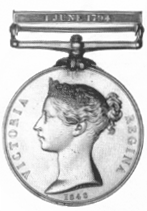
The Naval General Service Medal (NGSM) was a campaign medal approved in 1847, and issued to officers and men of the Royal Navy in 1849. The final date for submitting claims was 1 May 1851. Admiral Thomas Bladen Capel was one of the members of the board that authorised the medal.

The Military General Service Medal (MGSM) was a campaign medal approved in 1847 and issued to officers and men of the British Army in 1848.

The Indian General Service Medal was a campaign medal approved on 3 August 1938, for issue to officers and men of the British and Indian armies, and of the Royal Air Force.

The Crimea Medal was a campaign medal approved on 15 December 1854, for issue to officers and men of British units which fought in the Crimean War of 1854–56 against Russia. The medal was awarded with the British version of the Turkish Crimea Medal, but when a consignment of these was lost at sea, some troops received the Sardinian version.

The Baltic Medal was a campaign medal approved on 6 June 1856, for issue to officers and men of the Royal Navy, Royal Marines, and Royal Sappers and Miners who served between March 1854 and August 1855 in the Baltic Sea operations against Russia in the Baltic theatre of the Crimean War, or Åland War. The medal primarily covered naval actions but was also awarded to 106 men of the Royal Sappers and Miners who were landed to place demolition charges against Russian fortifications at Bomarsund and Sveaborg.

The Army of India Medal (AIM) was a campaign medal approved in 1851 for issue to officers and men of the British Army and the Army of the Honourable East India Company. A retrospective award following the precedent set by the Naval General Service Medal and the Military General Service Medal, it served to reward service in various actions from 1803 to 1826.

The Punjab Medal was a campaign medal issued to officers and men of the British Army and Honourable East India Company who served in the Punjab campaign of 1848-49, which ended in the British annexation of the Punjab.

The Sutlej Medal was a campaign medal approved in 1846, for issue to officers and men of the British Army and Honourable East India Company who served in the Sutlej campaign of 1845–46. This medal was the first to use clasps to denote soldiers who fought in the major battles of the campaign.

The India Medal was a campaign medal approved in 1896 for issue to officers and men of the British and Indian armies.

The East and Central Africa Medal, established in February 1899, was a British campaign medal awarded for minor military operations in the Uganda Protectorate and Southern Sudan between 1897 and 1899. Four separate clasps were issued.
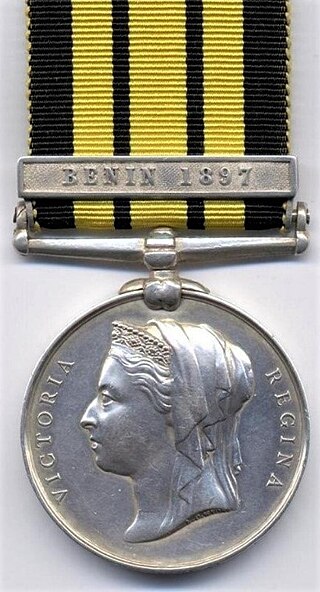
The East and West Africa Medal, established in 1892, was a campaign medal awarded for minor campaigns that took place in East and West Africa between 1887 and 1900. A total of twenty one clasps were issued.
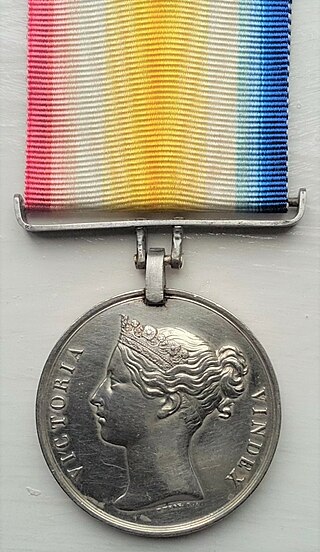
The Candahar, Ghuznee, Cabul Medal was awarded to those who took part in the campaign in the spring and summer of 1842, under the command of General William Nott, to restore British standing in Afghanistan after earlier defeats during the First Anglo-Afghan War.
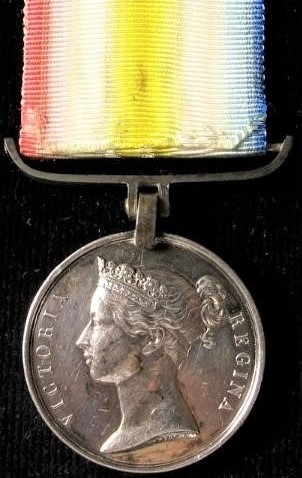
The Scinde Medal was authorised on 22 September 1843 and issued to soldiers of the Honourable East India Company, the 22nd Regiment of Foot of the British Army and members of the Indian Navy who crewed the Indus Flotilla, who participated in Major General Sir Charles Napier's conquest of Scinde between 1842 and 1843.

The Africa General Service Medal, established in 1902, was a campaign medal of the United Kingdom. It was awarded for minor campaigns that took place in tropical Africa between 1900 and 1956, with a total of forty five clasps issued. The medal is never seen without a clasp and some are very rare. Most medals were granted to British led local forces, including the King's African Rifles and the West African Frontier Force. The only campaigns where European troops were present in any numbers were the various Somaliland campaigns,, and in Kenya.

The Queen's Sudan Medal was authorised in March 1899 and awarded to British and Egyptian forces which took part in the Sudan campaign between June 1896 and September 1898.

The Ashanti Medal was sanctioned in October 1901 and was the first campaign medal authorised by Edward VII. This medal was created for those troops engaged in the Third Ashanti Expedition, also known as the War of the Golden Stool. This expedition lasted from March – December 1900, with the final outcome that the Ashanti maintained its de facto independence. Ashanti was made a Protectorate of the British Empire, but they ruled themselves with little reference to the colonial power.

The Jellalabad Medal was a campaign medal issued by the British East India Company. It was established by Lord Ellenborough, the Governor-General of India, on 30 April 1842.
The medal was awarded for the defence of Jalalabad from 12 November 1841 to 7 April 1842, during the First Afghan War, to the troops under the command of Sir Robert Sale. About 2,600 soldiers took part, including the 13th Foot, the 35th Bengal Native Infantry, as well as detachments from other Indian Army units and some loyal Afghan forces.

The Kelat-I-Ghilzie Medal is a campaign medal issued by the British East India Company, to the defenders of the fort at Kelat-I-Ghilzie during the First Anglo-Afghan War.

The Sardinian Crimean War Medal or, more formally, the silver medal for Military Valour for the Eastern Expedition 1855–1856 was a gallantry medal awarded by King Victor Emmanuel II of Sardinia for bravery during the Crimean War (1855–1856) against the Russian Empire. It is a variant of the Sardinian Medal of Military Valor.
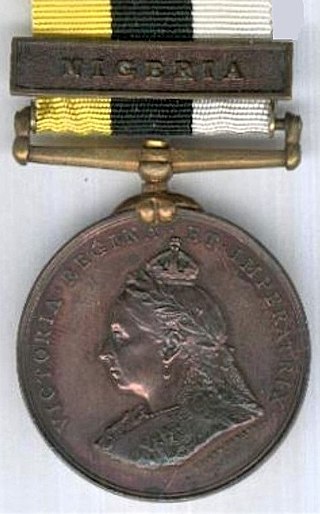
The Royal Niger Company’s Medal was a campaign medal issued in 1899 by the Royal Niger Company for service in minor military operations in Nigeria between 1886 and 1897. The award was approved by the British government and could be worn by British servicemen.
